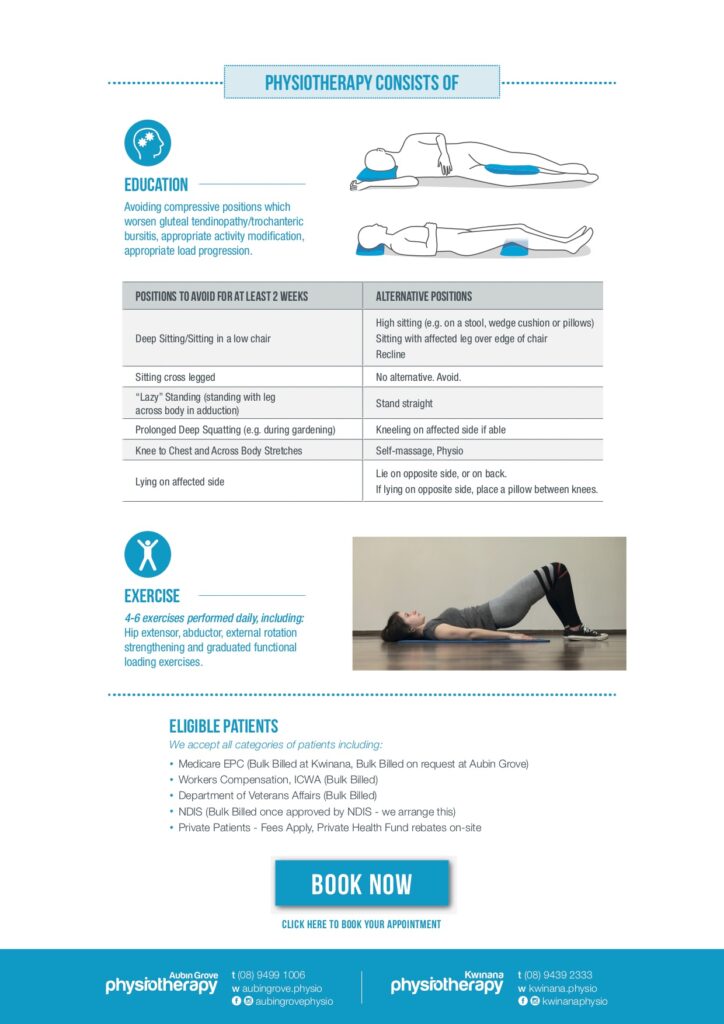Pain Caused by Bursitis or Gluteal Tendinopathy Responds Best to Physiotherapy
If you’re suffering from lateral hip pain caused by conditions like gluteal tendinopathy or trochanteric bursitis, you’ll want to pay attention to some groundbreaking research. The British Medical Journal recently published the results of the LEAP trial, which compared different treatment approaches for this common hip injury. And the results are incredibly promising for physiotherapy.
The LEAP trial looked at three different treatment options:
1) Physiotherapy involving primarily education and exercise
2) Corticosteroid injection, and
3) Simply waiting it out with no treatment.
By evaluating patients’ global improvement and pain levels at 4,8, 12, 26 and 52 week follow-up appointments, the researchers found physiotherapy to be the clear winner.
Let’s dive into exactly what the data showed:
For global improvement (i.e. percentage of patients reporting successful treatment), at 8 weeks Physiotherapy had a 77% success rate compared to only 58% for injection and 29% for no treatment. At 52 weeks, the physiotherapy success rate maintained at an impressive 78%, while the injection was 57% and no treatment was just 52%.
When it came to actual pain reduction over time, the graphs shown below tell an equally convincing story. Patients started out with an average pain level around 5/10 on a 0-10 scale. By 8 weeks, the Physiotherapy group’s average pain dropped to around 1.5, compared to 2.7 for injection and 3.8 for no treatment. And at 52 weeks, physiotherapy got pain levels down to 2.1 on average, while injection was 2.3 and no treatment was still over 3.2.
So what exactly was involved in this powerful physiotherapy approach? The program focused on two main components:
1) Education on avoiding positions that compress the hip and worsen symptoms, like sitting cross-legged, deep squatting, or lying on the affected side. Proper activity modification and load progression were also covered.
2) A daily exercise routine of 4-6 exercises designed to strengthen the hip extensors, abductors, and external rotators while gradually reintroducing functional loading.
Manual Therapy, although not covered in this specific study has also been shown to help with the pain associated with gluteal tendinopathy and trochanteric bursitis and is incorporated in our treatment approach for lateral hip pain at Kwinana Physiotherapy.
The bottom line? If you’re dealing with stubborn lateral hip pain from gluteal tendinopathy, trochanteric bursitis, or other related conditions, physiotherapy is shown to be the most effective treatment option. With results nearing an 80% success rate and average pain dropping from 5/10 to 1.5-2/10, seeking out professional physiotherapy is a no-brainer.
Note, that while physiotherapy was superior when studied in isolation, there may still be specific patients who will benefit from a corticosteroid injection. Combining the two treatments (i.e. a corticosteroid injection, followed by a period of physiotherapy) is an excellent approach for many patients.
At Kwinana Physiotherapy, our physiotherapists are experienced in designing customised rehabilitation programs to treat lateral hip pain successfully. Don’t simply “wait it out” – physiotherapy offers a proven path to recovery based on this exciting new research. Contact us today to request an appointment.



